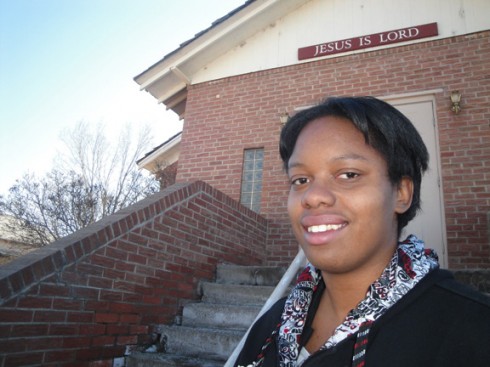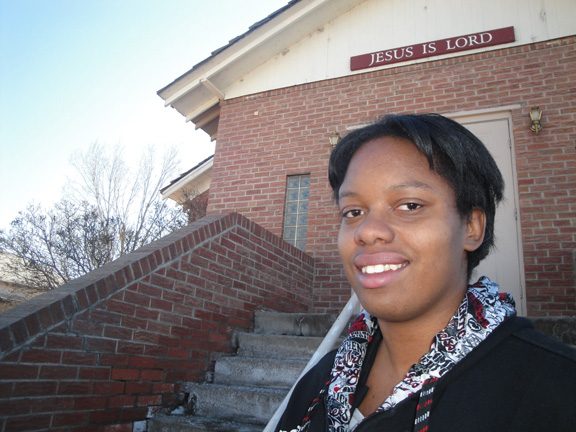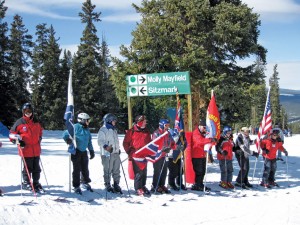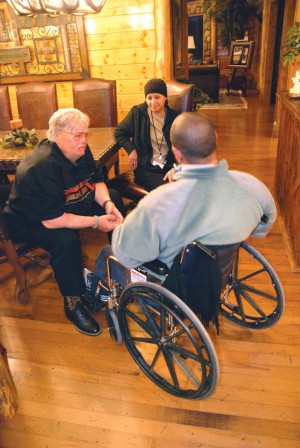By Ann Marie Swan
Alamosa may be a little bit of heaven on earth for Afghanistan Army veteran Spc. Mary Harmon. It’s where she found healing, peace, grace and redemption.
Harmon’s journey home from Afghanistan has been a bumpy one as she’s transitioned to life after the military. She’s tried to soothe her post-traumatic stress disorder, sometimes drinking and drugging. PTSD is an anxiety disorder that can occur following a traumatic event, according to the National Center for PTSD. PTSD is a normal reaction to a horrific experience and it’s as old as combat.

A statuesque, healthy woman married to a man from Manassa and living in Alamosa, Harmon is noticeable. Her first international experience was on Bagram Air Force Base, Afghanistan, where she worked jobs supporting the prison. She recalls that deployment, which ended in July 2009, as “terrifying.” “We got mortared a lot,” she said. “People would go to sleep and not wake up.”
Harmon joined the Army in 2005, following in the footsteps of her veteran father and grandfather. She endured her tour by going into “battlefield mindset” and “robot mode,” settling into a routine of working, exercising, eating and sleeping. “You don’t really think about your emotions,” she said. “You go into a heightened sense of alertness and what you were trained to do.”
Death was a constant reminder at Bagram, an exit point for fallen comrades en route to the United States. Ceremonies for them were continual, honoring their service, mourning their shortened lives. The day Harmon left Bagram was especially rattling, as her unit was shelled unmercifully after word got out of the deployment. It was a fitting send-off to her time spent there, affirming that she would be truly blessed to get out alive.
When Harmon returned to the United States, she joined her fiancee, Pfc. Joseph Harmon, at Fort Drum, New York. Deployed in separate conflicts, he in Iraq, they met online. They bonded over both being pastors’ children and similar likes, including the band Linkin Park, strawberry cheesecake and Mountain Dew. Their rapport was so comfortable, “it was scary,” Mary Harmon said. In fact, they married three days after meeting in person.
The couple settled into married life outside Fort Drum in Watertown, New York, where their experiences overseas began to haunt them. Harmon’s commanding officers had told her the war “starts at the end of your boots.” She knew the enemy could be anywhere or anyone, even a child. Going to a crowded mall was unnerving. Harmon felt anxious and cautious. Her distress made it “harder to connect with people,” she said. This hyper-vigilance hung around like a unwanted ghost.
Hearing about a loved one’s wartime experience worsened the pain. During Joseph Harmon’s tour in Iraq, he worked with an acquaintance one day, attended his funeral the next. Raw emotions and memories, some suppressed, began to surface. Mary Harmon said, “We were trying to cope with everything that we saw.” While Joseph Harmon was still active duty at Fort Drum he faced an upcoming deployment, likely to Afghanistan.
Together, the couple found solace self-medicating. “We drank and did any kind of drugs we could, whatever was convenient to get,” Harmon said. “We had addictions.”
As bad as it was, Harmon laughed, talking about those days. “I thought I had standards – no crack or heroin,” she said. “I grew up in Detroit.”
More than ever before, combat veterans are seeking care for PTSD, but not everyone. A RAND survey shows that 18.5 percent of vets deployed since 2001 have PTSD or major depression, and half of them have sought treatment. The Department of Veterans Affairs promotes easy access to care and its spectrum of services. The VA has greatly expanded its network of community-based clinics and vet centers, and is renowned for PTSD research and treatment. Live video can connect vets with clinicians. There’s even a mobile app, PTSD Coach.
Yet, a disconnect remains between vets who need help and aren’t getting it. Reasons range from being seen as weak to privacy concerns to not believing treatment is effective. Some can’t relate to the therapist. Others can’t get an appointment in a reasonable amount of time.
Harmon didn’t seek out mental health services because “you don’t want to admit something is wrong.”
The military trained Harmon to consider her battle buddy before herself. “The most important person is standing next to you,” Harmon said, “even if you don’t particularly like him or her.”
Donald Romero, an outpatient therapist at San Luis Valley Comprehensive Community Mental Health Center in Alamosa, said, “There’s a huge difference between military and civilian cultures” and the transition isn’t always easy. Romero would know. He was an infantryman and deployed to Kuwait in 1993. He also spent time in Macedonia in 1994 with a U.N. peacekeeping force.
“We were taught, and constantly reinforced, to not express feelings,” Romero said. “If you get scared or sad or depressed and freeze up on the battlefield, that could get you or your squad members killed. There’s a huge push to not be emotional. This could be seen as a sign of weakness.”
Troops learned to “put that stuff on the back burner,” he said.
This training may interfere with opening up about sleeplessness, feeling isolated or exposed, or other worries. “It goes back to the well-conditioned, well-oiled machine of a soldier,” Romero said.
Meanwhile, outreach to struggling vets is gaining momentum. Romero hangs flyers about services around town, including in bars and liquor stores. He’s participated in a fair with a plethora of information for vets. Vets are also looking to each other for support, meeting for coffee or organizing retreats. A club for veterans is forming at Adams State College.
Psychologist Lawrence Wahlberg, Ph.D, is program manager of the PTSD residential rehabilitation treatment program with the VA’s Eastern Colorado Health Care System in Denver. Wahlberg said: “We’re working hard to get the word out. We want vets to come into the VA for help now. We’ve got services to meet their needs right where they are.”
He has seen “remarkable progress” in the past ten years, particularly with cognitive processing therapy, which focuses on how thoughts of trauma cause stress and worsen symptoms. Prolonged exposure therapy is another method to treat PTSD, with the goal of reducing fear about memories. After therapy, vets often report fewer and less frequent symptoms, and function better despite them.
The measure of success is reflected in a vet’s quality of life. A combat vet may still have nightmares but enjoy family relationships and function well at work. Ideally, vets move closer toward the lives they want to live.
Wahlberg’s also seen hopeful, dramatic results in substance abuse treatment. There’s “no wrong door” into services as access broadens, he said.
But vets who are not in crisis can wait a long time to get treatment at the VA. “There’s a lot of apathy,” said Stephen Redmond of Salida, who spent 20 years in the Air Force. Redmond graduated the Air Force Academy in 1987, flew B-52s for 14 years, then worked on the ground calling airstrikes. He’s served in Bosnia, Kosovo and Iraq.
After calling the VA five times over five days, he sent an email, trying to get an appointment. It took more than four weeks to get a response.
Redmond finally saw a doctor who barely made eye contact while typing on his computer. “I felt I was bothering him,” Redmond said. After ruling out suicidal and homicidal thoughts, the doctor wrote a prescription, said he’d see Redmond in a year, and sent him on his way.
Redmond eventually connected with a helpful VA counselor in an unconventional manner, through a friend. He has also seen a therapist on his own dime.
Ultimately, the Harmons made their way home to the San Luis Valley. Everything changed for the couple after accepting an invitation to a church potluck. They didn’t realize a service preceded the meal and may not have attended had they known. But something moved them. “God touched us,” Harmon said.
After being stuck in their thoughts and lives, the Harmons’ world suddenly opened up and became brighter. Soon afterward, they were sober. “Everything stopped,” Mary Harmon said, “Even cigarettes. God knew.”
“I give all credit and praise to my lord, Jesus Christ,” Harmon said.
Lately, Joseph Harmon is feeling the call to become a pastor, his wife said. He’s currently working as a caregiver, a profession that holds some interest for Mary Harmon as well.
The Harmons, both 24, are thriving. Their lives have transcended into something exponentially larger than they once were. g
Salida resident Ann Marie Swan has worked as a daily journalist in Denver, Honolulu and Tokyo. She’s from New Orleans and owns the Salida Yoga Center. You may reach her at salidayogacenter@yahoo.com.




Great article! It seems like the cognitive processing therapy would work well with many kinds of mental stress.
Hi!
It’ss 3/21/12 and I just read this fabulous article. I am an Air Force Retiree and have both adhd and ptsd…thanks to USAF crisis, especially in the first 2 years of service. Voluntered for Vietnam, but was an only child, and couldn’t go. But I truly look up to the Veterans of today – they’re young, ambitious, driven and loyal. They are in wars our older Vets never dreamed about. God love each and every one of them!!!
San Juan Mtns are our favorite vacation spot. Love Ouray, and Pagosa Springs. Thought we could get there this year, but we won’t. Maybe next year.
You may email me anytime and hopefully we’ll meet one day! I’d feel priviledged, believe me.
Thanks for the article and may God Bless all of you and AMERICA!!
PJ Doherty